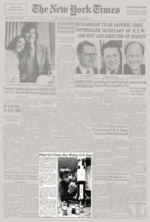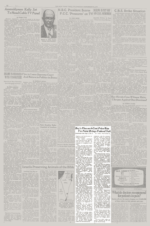Think paint is expensive now?
Do you ever think back about how cheap things used to be? I suspect each of us has a distinct memory of some item that stood out from our childhood as being unbelievably inexpensive, especially as compared to today’s prices. For me, I can vividly remember gas station signs proclaiming the cost per gallon to be 88 cents (roughly 1984). Although I was building my first models around the same time, I have no recollection of the material costs, but can certainly picture my model table with an assortment of Testors Enamel paints strewn about. When discontinued around 2020, the beloved, square, 1/4 ounce jars of nostalgia cost anywhere from $1.99-$2.69, but can you remember when it was 19 cents? In 1972, one Long Island boy learned that the paint price had increased from 15 cents to 19 cents and decided to complain to the government, which turned into a Federal lawsuit against Testors Corporation and landed him on the front page of the the NY Times.
Here is the full article text, but the NY Times version can be found here.
WASHINGTON, Nov. 28— Prodded by a 13‐year‐old Long Island boy who builds and launches model rockets, the Justice Department today accused the manufacturer of illegally raising the price of a paint used by the boy.
A civil suit filed in Federal court in Chicago charged that the Testor Corporation of Rockford, Ill., violated the Federal wage ‐ price controls program by increasing the suggested retail price on a quarter‐ounce jar of enamel paint to 19 cents from 15 cents.
“Of 20 million or so little bottles of paint we sell, we’ve had only one complaint,” said Charles D. Miller Jr., opera tions manager of Testor. Mr. Miller said the company be lieved the price increase was legal and that it would defend the suit.
The one customer who decided he could do something about the price increase was John Malachowsky of 88 Columbus Avenue, West Babylon, L. I., an eighth grader.
A builder of model rockets and airplanes since he was eight, John was a regular shopper of kits and paints at the Great South Bay Shopping Center on Montauk Highway and had become inflation‐conscious.
“The rocket catalogues went from $4 to $6, right be fore the price controls,” he recalled in a telephone interview.
Then, one day last winter his mother bought some paint for him — at 19 cents.
“She doesn’t know the difference,” he said. “When I saw it, I said no more of this stuff. I switched to a 15‐cent brand. I don’t get as good results but it’s not worth 4 cents extra.”
After vacillating for a few days, John made up his mind to complain to the Government. He said he wrote in mid‐March. The Government said he wrote on April 6.
“It got lost somewhere,” he said, “It took about two weeks to get there.”
His typewritten postcard, addressed to “the Price Commission Complaint Dept. Washington, D.C.,” read as follows:
“Dear sirs: I am making a formal complaint against The Testors Corp., Rockford, Ill. 61101 USA. They raised their ‘Pla Enamel’ 30 percent, or from $.15 to $.19. This is only $.04, but being only 12¾ years old, this is a big strain on allowance. Thank you. A concerned consumer! John Malachowsky.”
That set the wheels in motion. The Price Commission referred the complaint to the Internal Revenue Service, its field enforcement arm. The I.R.S. office at Rockford sent an agent to the Testor plant.
He learned, the suit filed today said that Testor had increased its prices for the paint jars by 26.5 per cent, to $12.31 from $9.72 at wholesale, for a gross, and to 19 cents a jar suggested retail price.
On May 10, the Internal Revenue Service issued a notice of violation to Testor charging that the price increase had not been justified on the basis of increased costs.
On May 31, Jupiter Indus tries, Inc., of Chicago, which has an 80 percent interest in Testor, applied to the Price Commission for an exception that would allow the price rise. It was denied on Aug. 25. On Oct. 3 the company asked for reconsideration.
Mr. Miller, interviewed by telephone, said the company had not raised its price for 10 years. It began printing “19 cents” on caps in April, 1971, he recalled, and be gan putting the new caps on bottles on Aug. 13, 1971, two days before President Nixon announced a wage price freeze.
“I can remember specifically sitting down watching Mr. Nixon on TV announce what he was doing,” Mr. Miller said.
John Malachowsky said he, too, remembered that speech and also one the President made in November, 1971, announcing Phase Two of the controls program, under which the Government sought to limit price increases to 2.5 percent a year.
John said that his memory of that speech, his belief that Mr. Nixon was “doing a good job, he was trying,” and his own difficulties in coping with inflation on an allowance of $2 a week led him to write his postcard, the first time he had ever written to the Government.
According to a spokesman for the Cost of Living Council, which announced the suit, Internal Revenue agents repeatedly and unsuccessfully sought assurances from Testor that it would rescind the increase voluntarily.
Mr. Miller, meanwhile, in three trips to Washington, pressed the Price Commission for an exception.
The Justice Department also said that Testor increased the price of its spray can of paint by 14 percent, to 79 cents from 69 cents.
The complaint asked the court to order Tester to roll back its prices and to reduce them temporarily by an additional amount to give customers a saving equivalent to the $150,000 allegedly collected illegally. The department also asked for a penalty of $2,500 for each violation of the Economic Stablization Act.
While Testor and the Government were jousting, John set about dealing with inflation as best he could. He negotiated with his parents, John and Antonette Malachowsky, for a bigger allowance.
“It’s up to $4,” John reported, “because of the rise in the cost of living.





